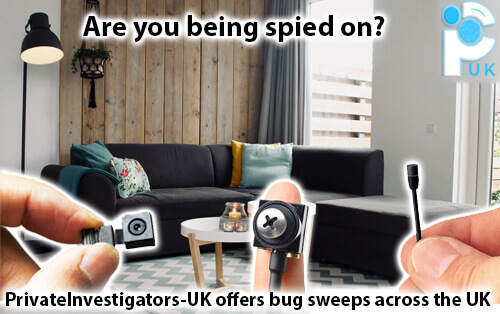Within our private investigation practice, we frequently encounter espionage devices, often referred to as spy bugs. Modern surveillance technology includes hidden microphones, covert cameras, and vehicle trackers. The other side of our work is bug sweeping, also called TSCM sweeps, where we detect and remove these devices to restore privacy and security.

Quick Navigation
What Are The Different Types of Bugs?
Surveillance bugs generally fall into three main categories:
1. Hidden Microphones
Listening devices remain common, particularly in business settings. These hidden microphones can capture conversations without consent, creating serious privacy concerns.
2. Concealed Cameras
Modern hidden cameras are small and easily disguised inside ordinary objects such as alarm clocks, phone chargers, bags, or picture frames. While sometimes used for legitimate investigations, they are also misused in illegal ways.
3. Vehicle Trackers
GPS trackers are attached to vehicles, often with magnets, and provide real-time location data. Some can last for months without recharging. These are widely used in both professional investigations and unfortunately in unlawful stalking.
Reasons Behind the Use of Spy Bugs
Motivations vary widely. Parents sometimes use monitoring software on their child’s phone, while suspicious partners may install trackers or cameras. In businesses, bugs are used to gather intelligence on employees or competitors. Unfortunately, some people use them for criminal or predatory purposes. The low cost and easy availability of such devices online has made misuse more common.
What is a TSCM Bug Sweep?
Technical Surveillance Counter Measures (TSCM), commonly known as bug sweeps, are specialised counter surveillance services designed to detect and remove hidden devices such as microphones, cameras, and GPS trackers. A TSCM sweep also highlights vulnerabilities in your home, office, or vehicle that may allow surveillance equipment to be planted.
Learn more about our dedicated bug sweep service in the UK.
What is the Procedure for a Bug Sweep?
Our bug sweep process begins with a consultation to understand your concerns. We then visit the location, using advanced equipment to scan for suspicious transmissions, hidden lenses, or anomalies. Manual inspection is combined with electronic detection to maximise accuracy. After the sweep, we provide a detailed report and advice for ongoing protection.
What Equipment is Used During a Bug Sweep?
- Near-Field Detection Receivers
- Non-Linear Junction Detectors
- Spectrum Analysis Detectors
- GSM Locators
- Thermal Imaging Devices
- Wi-Fi Scanners
- Endoscope Cameras
- Lens Detection Tools
- Metal Detectors
- Forensic Light Sources
- Video Pole Cameras
These tools are expensive and require professional training. The expertise of our operatives is what makes a bug sweep effective.
How Much Do Bug Sweeps Cost?
Costs depend on property size and location. Typically, bug sweeps in the UK cost a few hundred pounds. Our team uses professional-grade tools worth thousands, but the real value lies in the experience of trained operatives. We provide free, no-obligation quotes tailored to your property.
Request a bug sweep quote today.
How Long Do Bug Sweeps Take?
A small home may take around 3–4 hours, while larger properties can take a full day. Duration depends on the number of rooms, complexity of the site, and level of access.
Personal Vigilance Against Spy Bugs
Educating yourself is an important defence. Thousands of cheap spy devices are available online, often disguised inside everyday objects. Awareness of how they look and where they might be hidden can help you recognise suspicious items. If you are concerned, it is always safest to instruct professionals to check your property.
Related article: 7 Signs that Your Home Is Bugged
Concluding Thoughts
The growing demand for bug sweep services reflects how common hidden surveillance has become. Whether in homes, offices, or vehicles, a TSCM sweep can restore privacy and peace of mind. For advice or to schedule a sweep, contact our team with the size and location of your property.
